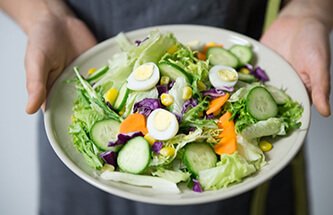Pancreatic Cancer Symptoms

Pancreatic cancer often goes undetected until it’s advanced and difficult to treat. In the vast majority of cases, symptoms only develop after pancreatic cancer has grown and begun to spread. Any symptoms people do have can be quite vague and may come and go at first. An example is abdominal pain, which may start off as occasional discomfort before becoming more painful and more frequent. The symptoms can also be a sign of other more common illnesses such as pancreatitis, gastritis, gallstones or hepatitis.
Most common symptoms of pancreatic cancer – Most pancreatic cancers are exocrine tumours (95%). Their symptoms can be very vague and depend on whether the tumour is in the head, body or tail of the pancreas.
- Abdominal Pain – Pain is a symptom in about 70% of pancreatic cancer cases. It often starts as general discomfort or pain in the abdomen (tummy) which can spread to the back. It can be worse after eating or when you are lying down. Sitting forward can sometimes relieve the pain. At first the pain may come and go, but over time it may become more constant. If any of the organs (pancreas, liver or gall bladder) in your abdomen are inflamed or enlarged the area may also be tender to touch.
- Jaundice – Jaundice occurs in about 50% of pancreatic cancer cases. The most common signs
of jaundice are that the skin and the whites of the eyes turn yellow. Other signs include dark urine, pale stools (poo) and itchy skin. Jaundice develops when there is a build-up in the blood of a substance called bilirubin. The substance is a by-product of red blood cells breaking down and is always present in the blood. It usually gets removed from the body in the bile fluid produced by the liver which empties into the small intestines through the bile duct. Cancer growing in the pancreas can block the bile duct so that bile and bilirubin keep building up in the body. This is known as obstructive jaundice.
- Digestive problems –
- Pale, greasy stools: If cancer blocks the release of the pancreatic juice into the intestine, a person might not be able to digest fatty foods. The undigested fat can cause stools to be unusually pale, bulky, greasy, and to float in the toilet.
- Nausea and vomiting: If the cancer presses on the far end of the stomach it can partly block it, making it hard for food to get through. This can cause nausea, vomiting, and pain that tend to be worse after eating.
- Blood clots – Sometimes, the first clue that someone has pancreatic cancer is the development of a blood clot in a large vein, often in the leg. This is called a deep venous thrombosis or DVT. Symptoms can include pain, swelling, redness, and warmth in the affected leg. Sometimes a piece of the clot can break off and travel to the lungs, which might make it hard to breathe or cause chest pain. A blood clot in the lungs is called a pulmonary embolism or PE. Still, having a blood clot does not usually mean that you have cancer. Most blood clots are caused by other things.



